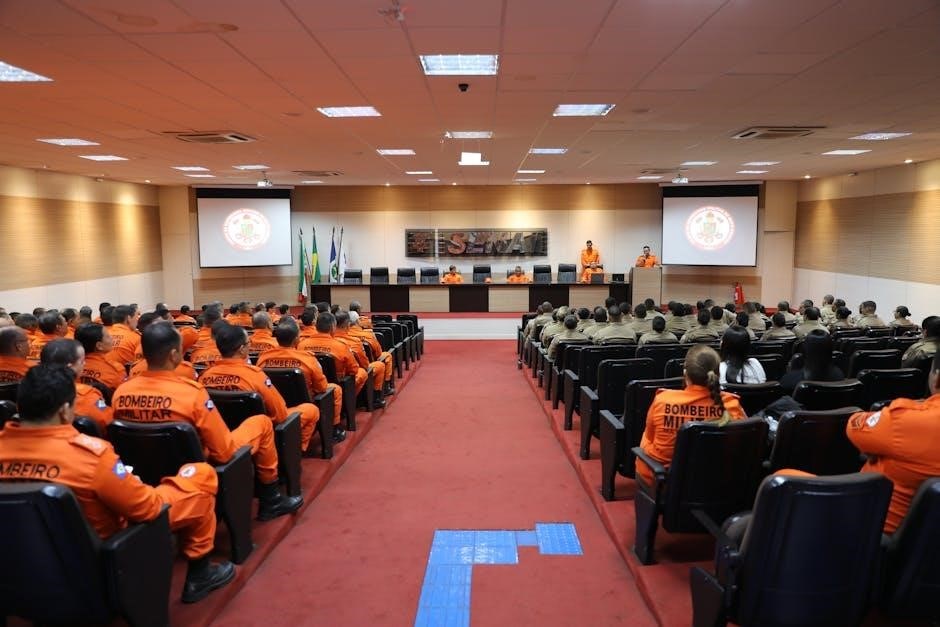Embark on your 70.3 triathlon journey with a structured training plan designed to build endurance, strength, and mental resilience across swimming, cycling, and running disciplines.
1.1 What is a 70.3 Triathlon?
A 70.3 triathlon, also known as a half-Ironman, consists of a 1.9-kilometer swim, 90-kilometer bike ride, and 21.1-kilometer run, totaling 70.3 miles from start to finish. This endurance event demands a balanced blend of physical fitness, mental toughness, and strategic pacing. It is considered a stepping stone for athletes aiming to progress to full Ironman distances, while still posing a significant challenge for even experienced competitors. The event requires meticulous preparation, making a well-structured training plan essential for success;
1.2 Importance of a Structured Training Plan
A structured training plan is essential for achieving success in a 70.3 triathlon. It helps athletes avoid overtraining, ensures consistent progress, and balances swim, bike, and run workouts. By following a well-designed plan, triathletes can build endurance, strength, and speed systematically. A structured approach also provides accountability, helping athletes stay motivated and focused on their goals. It ensures proper recovery and progression, reducing the risk of injury. Ultimately, a structured plan builds confidence and prepares athletes mentally and physically for the demands of race day.
1.3 Benefits of Using a PDF Training Plan
A PDF training plan offers a clear, structured, and accessible guide for 70.3 triathlon preparation. It provides a customizable roadmap, allowing athletes to track progress and stay accountable. The format ensures consistency, making it easy to follow and reference. PDF plans are also shareable with coaches or training partners, fostering collaboration and support. Additionally, they eliminate the need for costly software, offering a budget-friendly solution. With a PDF, athletes can easily integrate the plan into their daily routine, ensuring they stay on track toward their 70.3 goals. This format is both practical and efficient for triathlon training.

Overview of a 70.3 Training Plan
A 70.3 training plan provides a balanced approach to triathlon preparation, combining swim, bike, and run workouts with periodized structure to enhance endurance, strength, and race-day performance.
2.1 Understanding the Three Disciplines
A 70.3 triathlon consists of three distinct disciplines: swimming, cycling, and running. Each requires unique skills and physical demands. Swimming focuses on endurance and technique in open water or pools. Cycling demands sustained power and cadence over long distances. Running builds stamina for the final push. Understanding these components helps athletes tailor their training to address individual weaknesses and strengths. A structured plan ensures balanced development across all three, leading to a cohesive and strong race performance.
2.2 Key Components of the Plan
A well-structured 70.3 training plan includes key components such as progressive workload increases, periodized phases, and a balance of endurance, strength, and speed workouts. It also incorporates nutrition advice, recovery strategies, and metrics tracking to monitor progress. Each phase is designed to build specific skills and endurance, ensuring athletes peak at the right time. The plan also includes transition workouts and race-specific simulations to prepare for the demands of race day. This holistic approach ensures comprehensive preparation for all three disciplines.
2.3 How to Choose the Right Plan
Choosing the right 70.3 training plan involves assessing your fitness level, goals, and schedule. Select a plan that aligns with your experience, whether you’re a beginner or advanced athlete. Consider the plan’s structure, ensuring it includes balanced training across swimming, cycling, and running. Look for a plan that offers flexibility to adapt to your lifestyle and progress. Consult with a coach or experienced triathlete to tailor the plan to your needs. Ensure the plan includes recovery strategies, nutrition advice, and gradual progression to avoid burnout and optimize performance.
Swim Training for 70.3
Master the fundamentals of swim training to build stamina, technique, and race-specific skills essential for a strong 70.3 triathlon performance and overall endurance.
3.1 Building Endurance in the Water
Building endurance in the water is crucial for a successful 70.3 triathlon. Start with long, steady-state swims to increase stamina. Incorporate interval and tempo sets to improve pacing and mental toughness. Focus on consistent training, gradually increasing distance and intensity. Include drills to enhance efficiency and reduce fatigue. Strength exercises, like pull-ups and core work, can also boost endurance. Aim to swim at least 3-4 times a week, ensuring progressive overload. Over time, this structured approach will build the aerobic capacity needed for the 1.9-mile swim leg of your 70.3 event.
3.2 Improving Technique for Efficiency
Enhancing swimming technique is crucial for efficiency and reducing energy expenditure. Focus on stroke mechanics, body positioning, and minimizing drag. Incorporate drills like catch-up and fist drills to refine your stroke. Strengthen your kick and optimize arm movements for better propulsion. Use flip turns and streamlining to maintain flow. Regular video analysis can provide actionable feedback. Practice breathing techniques to stay relaxed and maintain rhythm. Consistent attention to form ensures long-term progress, making every stroke count toward race-day performance.
3.3 Incorporating Brick Workouts
Brick workouts are essential for 70.3 training, involving back-to-back sessions in two disciplines, such as bike-to-run or swim-to-bike, to simulate race-day transitions. These workouts enhance muscular endurance, reduce fatigue during transitions, and improve mental resilience. By mimicking the physical and mental demands of race conditions, brick workouts help triathletes adapt to the unique challenges of multi-sport events. Incorporate brick sessions gradually into your training plan, starting with shorter distances and increasing intensity as fitness improves. This approach ensures a seamless transition on race day and boosts overall performance.

Bike Training for 70.3
Enhance your 70.3 bike performance with endurance rides, strength exercises, and speed workouts. Focus on cadence, pacing, and gear efficiency to maximize your cycling potential.
4.1 Increasing Cycling Endurance
Increasing cycling endurance is crucial for a strong 70.3 performance. Focus on long, steady-paced rides to build aerobic capacity and muscular stamina. Incorporate tempo sessions and endurance intervals to enhance lactate threshold. Consistency is key—aim for weekly long rides and shorter, high-intensity workouts. Gradually increase mileage to avoid burnout, allowing time for recovery. Proper pacing and gear selection can optimize efficiency. Strength training for the lower body and core will also support endurance gains. A well-structured cycling plan ensures you’re race-ready and confident for the 56-mile bike segment.
4.2 Building Strength and Speed
Building strength and speed on the bike is crucial for a strong 70.3 performance. Incorporate high-intensity interval training (HIIT) and strength-focused workouts to enhance power output. Hill repeats and sprint intervals improve anaerobic capacity and acceleration. Structured sessions like tempo rides and cadence drills boost lactate threshold and pedaling efficiency. Strength training off the bike, such as squats and lunges, reinforces muscular endurance. Consistency in these workouts ensures sustainable progress, translating to faster splits and better overall race performance. Periodization of strength and speed phases ensures peak readiness for race day.
4.3 Transitioning from Bike to Run
Mastering the transition from bike to run is crucial for a seamless 70.3 race performance. Practice brick workouts, which combine cycling and running, to adapt your body to the change. Focus on quick gear transitions and efficient movement during training. Incorporate race-specific strategies, such as walking or jogging to manage fatigue. Simulate race-day conditions to build confidence and reduce anxiety. Transition drills should be included in your training plan to improve overall efficiency and mental preparedness for race day.

Run Training for 70.3
Focus on building endurance, speed, and stamina through tailored running workouts, ensuring a strong finish in the final leg of your 70.3 triathlon journey.
5.1 Enhancing Running Endurance
Building running endurance is crucial for a 70.3 triathlon. Start with long slow distance (LSD) runs to increase stamina. Incorporate interval training and tempo runs to improve lactate threshold. Gradually increase weekly mileage to build tolerance. Focus on consistent pacing and proper form to reduce injury risk. Include brick workouts (bike-to-run) to simulate race conditions. Strength training for legs and core can enhance running efficiency. Ensure adequate recovery between intense sessions to allow adaptation. Progressively overload your system to achieve sustainable endurance gains over time.
5.2 Incorporating Speed and Interval Workouts
Incorporating speed and interval workouts into your run training enhances running efficiency, boosts speed, and improves endurance. These workouts involve alternating between periods of high-intensity effort and active recovery. For example, 400m repeats or tempo runs at threshold pace can significantly improve lactate threshold and running economy. Start with shorter intervals and gradually increase distance and intensity as fitness improves. Always include a proper warm-up and cool-down to prevent injury and promote recovery. Consistency in these workouts will translate to stronger, more confident performances during your 70.3 event.
- Improves lactate threshold and running economy
- Enhances speed and endurance
- Includes variations like tempo runs and interval repeats
- Requires proper warm-up and recovery
5.3 Managing Fatigue and Recovery
Managing fatigue and recovery is crucial for optimal performance in 70.3 training. Incorporate rest days, stretching, and foam rolling to reduce muscle soreness. Prioritize sleep and nutrition to aid recovery. Active recovery, such as light swimming or cycling, can enhance blood flow without overexertion. Listen to your body and adjust intensity to prevent burnout. Consistent recovery practices help maintain consistency, prevent injuries, and ensure peak performance on race day. Balancing rest and training is key to long-term success in endurance events.

Nutrition and Fueling for 70.3 Training
Proper nutrition is essential for optimizing performance, recovery, and overall success in 70.3 triathlon training. Focus on balanced fueling, hydration, and electrolyte management to sustain endurance efforts.
6.1 Importance of Proper Nutrition
Proper nutrition is essential for optimizing performance and supporting your body’s demands during rigorous 70.3 training. A balanced diet rich in carbohydrates, proteins, and fats, along with adequate hydration and electrolytes, ensures sustained energy levels and recovery. Tailored nutrition plans help prevent fatigue, support muscle repair, and maintain immune function. By aligning your diet with training phases and goals, you can enhance endurance, strength, and overall race performance, making it a cornerstone of your 70.3 training plan.
6.2 Fueling Strategies for Long Workouts
A well-structured fueling plan is essential for long workouts in 70.3 training. Focus on consuming easily digestible carbohydrates 1-3 hours pre-workout. Aim for 30-60 grams per hour during sessions lasting over 60 minutes. Hydrate with 16-20 ounces of fluid 1-2 hours before starting and 6-8 ounces every 20-30 minutes during exercise. Include electrolytes to prevent cramps and maintain performance. Avoid heavy meals and opt for snacks like bananas, energy gels, or sports drinks. Experiment with different foods during training to find what works best for your body, ensuring optimal energy levels and preventing gastrointestinal distress.
6.3 Hydration and Electrolyte Balance
Proper hydration and electrolyte balance are crucial for optimizing performance and preventing dehydration during intense 70.3 training. Electrolytes like sodium, potassium, and magnesium regulate fluid balance and nerve function. Aim to drink 16-20 ounces of fluid with electrolytes 1-2 hours before workouts. During long sessions, consume 20-30 ounces of electrolyte-rich fluids per hour. Monitor urine color for hydration levels—pale yellow indicates proper balance. Avoid overhydration to prevent hyponatremia. Tailor hydration strategies to weather conditions and personal sweat rates for peak performance and recovery.

Recovery and Rest in Training
Recovery and rest are crucial for muscle repair, mental rejuvenation, and overall performance enhancement in a 70.3 training plan, ensuring sustained progress and injury prevention through proper techniques.
7.1 The Role of Recovery in Performance
Recovery is essential for optimal performance in 70.3 training, allowing your body to repair and adapt after intense workouts. It prevents overtraining, reduces muscle soreness, and enhances endurance. Adequate rest enables your body to replenish energy stores, rebuild muscle tissue, and strengthen the immune system. Mental recovery is equally important, helping to reduce stress and prevent burnout. By balancing training with recovery, athletes can achieve consistent progress, avoid injuries, and maintain peak performance levels throughout their training cycle. Recovery is not just a luxury—it’s a necessity for achieving your triathlon goals.
7.2 Techniques for Active Recovery
Active recovery involves low-intensity activities to promote blood flow and reduce muscle soreness. Techniques include swimming, cycling, yoga, and foam rolling. These methods enhance circulation, aiding in the removal of lactic acid and accelerating repair. Gentle movements like walking or light jogging can also be beneficial. Incorporating stretching and mobility exercises improves flexibility and joint health. Active recovery helps maintain consistency in training while reducing the risk of overtraining. It’s a crucial component of a balanced 70.3 training plan, ensuring athletes stay fresh and resilient throughout their preparation.
7.3 Importance of Sleep and Rest Days
Sleep and rest days are crucial for physical recovery, mental rejuvenation, and overall performance. During sleep, your body repairs muscles, replenishes energy stores, and enhances mental clarity. Consistent, high-quality sleep improves endurance, reduces injury risk, and boosts immune function. Rest days allow your body to adapt to training stress, preventing overtraining and burnout. Prioritizing sleep and incorporating scheduled rest ensures long-term consistency and success in your 70.3 training. Aim for 7-9 hours of sleep nightly and embrace rest days as essential components of your training regimen.
Periodization in 70.3 Training
Periodization structures training into focused phases, optimizing performance by balancing intensity, volume, and recovery to peak for race day.
8.1 Understanding Training Phases
Training for a 70.3 triathlon is most effective when divided into distinct phases, each with specific goals. Periodization involves organizing workouts into blocks, such as base building, strength, and speed phases. The base phase focuses on endurance, the strength phase on power, and the speed phase on intensity; Each phase builds on the previous one, ensuring progressive overload and adaptation. Understanding and aligning these phases with your race date is crucial for peaking at the right time. Consistency and patience are key to maximizing performance and race readiness.
8.2 Base Building, Strength, and Speed Phases
The training plan is divided into three distinct phases: base building, strength, and speed. The base phase focuses on building aerobic endurance through consistent, low-intensity workouts. The strength phase introduces interval training and hill repeats to enhance power and efficiency. Finally, the speed phase emphasizes tempo sessions and time trials to improve race-pace performance. Each phase progressively increases intensity and specificity, ensuring athletes are prepared for the demands of a 70.3 triathlon. Proper transition between phases is crucial for avoiding injury and maximizing performance gains.

Customizing Your 70.3 Training Plan
Tailor your 70.3 training plan by assessing fitness levels, aligning with goals, and adjusting for time constraints to enhance effectiveness and ensure a sustainable approach.
9.1 Assessing Your Current Fitness Level
Evaluating your current fitness level is crucial for creating an effective 70.3 training plan. Start by assessing your swim, bike, and run abilities through baseline tests such as a 1000m swim time trial, a 30-minute bike effort, and a 30-minute run. Use these results to determine your endurance, speed, and technique. Additionally, consider your overall health, injury history, and availability for training. This data helps establish a starting point, ensuring your plan is realistic, achievable, and tailored to your specific needs and goals.
9.2 Tailoring the Plan to Your Goals
Tailoring your 70.3 training plan to your specific goals ensures a personalized approach, maximizing progress and motivation. Assess your current fitness level and define clear, realistic objectives, whether it’s completing the race, achieving a personal best, or improving in a particular discipline. Adjust the intensity, volume, and focus of workouts to align with these goals. For example, emphasize endurance if you’re building a base or incorporate more speed work if targeting a competitive time. Incorporate goal-specific sessions, such as race-pace simulations or skill drills, to address weaknesses and enhance strengths. Regularly review and adapt the plan to stay on track and celebrate milestones, fostering consistency and confidence in your journey.
9.3 Adjusting for Time Constraints
To accommodate busy schedules, a 70.3 training plan can be tailored to fit limited time while maintaining effectiveness. Focus on prioritizing key workouts, such as high-intensity sessions and long endurance efforts, while reducing less critical exercises. Incorporate time-saving strategies like brick workouts, which combine two disciplines in one session. Additionally, shorten recovery periods slightly or integrate active recovery, like easy swims or walks, to maximize efficiency. Consistency and quality become more important than quantity, ensuring progress even with reduced training hours.

Monitoring Progress and Adjustments
Track your progress regularly using performance metrics to assess improvements. Analyze data to refine your training plan and make informed adjustments for optimal performance. Stay flexible to achieve your race goals.
10.1 Tracking Workouts and Metrics
Consistently tracking workouts and metrics is crucial for monitoring progress and optimizing your 70.3 training plan. Use a training log or app to record swim, bike, and run sessions, noting distance, time, heart rate, and pacing. Additionally, track recovery metrics like sleep quality, muscle soreness, and nutrition intake. Regularly reviewing this data helps identify trends, prevent overtraining, and make informed adjustments to your training. Over time, these insights will guide you toward peak performance and ensure you’re ready for race day.
- Document every session for transparency and accountability.
- Analyze progress to refine your training strategy.
- Use data to balance intensity and recovery effectively.
10;2 Making Adjustments Based on Progress
Regularly monitoring your progress allows for timely adjustments to your training plan. Analyze workout data, recovery levels, and overall performance to identify strengths and areas needing improvement. If goals are being met ahead of schedule, consider increasing intensity or volume. Conversely, if progress stalls, reassess workload or incorporate recovery weeks. Adjustments should be incremental to avoid overtraining. Stay flexible and prioritize consistency, ensuring the plan evolves with your fitness level and race preparation. This adaptive approach ensures continued progress toward your 70.3 goals.

Mental Preparation for 70.3
Mental preparation is crucial for a successful 70.3 triathlon, building resilience, focus, and confidence. Techniques like visualization, positive self-talk, and mindfulness help athletes overcome challenges and maintain composure under pressure.
11.1 Building Mental Endurance
Mental endurance is crucial for tackling the demands of a 70.3 triathlon. Techniques like mindfulness, positive self-talk, and mental rehearsal can help you stay focused and composed under pressure. Consistent mental training builds resilience, enabling you to push through discomfort and maintain confidence during long races. Incorporate visualization exercises to simulate race scenarios, fostering a mindset that thrives on challenge. Strengthening mental endurance ensures you can adapt to unforeseen obstacles and maintain peak performance, even when physical limits are tested. A strong mental game is as vital as physical conditioning for success in a 70.3 event.
11.2 Strategies for Staying Motivated
Staying motivated during a 70.3 training plan requires consistent mental and emotional engagement. Set clear, achievable goals and celebrate small victories to maintain momentum. Surround yourself with a supportive community, such as training groups or mentors, to share experiences and gain encouragement. Track your progress through journals or apps to visualize improvements. Vary your workouts to avoid monotony and incorporate activities you enjoy. Reward yourself for milestones reached, and remind yourself of your “why” to stay focused and driven throughout the journey.
11.3 Visualization Techniques
Visualization is a powerful mental tool to enhance performance in a 70.3 triathlon. By imagining yourself excelling in each discipline, you can build confidence and prepare for race-day scenarios. Close your eyes and vividly picture the swim, bike, and run, focusing on smooth transitions and overcoming challenges. Visualize crossing the finish line to reinforce a positive mindset. Regular practice strengthens mental resilience, helping you stay focused and composed under pressure. Use this technique to complement your physical training and gain a competitive edge.

Final Preparations for Race Day
Final preparations ensure peak performance, including a well-executed taper, thorough gear check, and nutrition planning. Stay mentally focused and confident for a successful race day.
12.1 Taper and Rest Before the Event
Proper tapering before a 70.3 event is crucial for peak performance. Reduce training volume 1-2 weeks prior to allow your body to rest and recover. Maintain some intensity to avoid detraining. Focus on active recovery, such as light swims or short runs, to stay sharp. Ensure adequate sleep and nutrition to replenish energy stores. Avoid introducing new activities or stressors during this period. Mental rest is equally important—stay calm and visualize success to maintain focus and confidence heading into race day.
12.2 Gear and Equipment Check
Ensuring your gear is race-ready is crucial for a smooth 70.3 triathlon experience. Check your bike for proper tire pressure, functioning brakes, and a clean chain. Verify your helmet’s fit and expiration date. Inspect your wetsuit for tears and ensure a snug fit. Goggles should be leak-free, and your running shoes should be well-broken-in. Test your hydration system and nutrition setup during training. Pack a race-day kit with essentials like spare tubes, energy gels, and sunscreen. Familiarize yourself with transition gear to avoid race-day stress. A pre-race checklist can help you stay organized and confident.
12.4 Race Day Strategy
A well-structured race day strategy is crucial for optimizing performance in a 70.3 triathlon. Start with a steady swim pace to conserve energy, then maintain consistent power on the bike while managing hydration and nutrition. Transition efficiently to the run, focusing on disciplined pacing to avoid early fatigue. Stay mentally tough, draw energy from the crowd, and execute a strong finish. Familiarize yourself with the course beforehand and ensure all gear is race-ready. Stay adaptable, trust your training, and embrace the moment to achieve your best performance.
Consistency, dedication, and smart training are key to conquering a 70.3 triathlon. Celebrate progress, stay disciplined, and trust the process for a successful race day experience.
13.1 Recap of Key Points
A well-structured 70.3 training plan is essential for success, balancing endurance, strength, and technique across swimming, cycling, and running. Proper nutrition, hydration, and recovery are critical for optimal performance. Periodization helps build a strong foundation, while mental preparation and race strategy ensure confidence on event day. Consistency, patience, and adherence to the plan are key to achieving your goals and crossing the finish line strong.
13.2 Final Tips for Success
Consistency, patience, and belief in your training are key. Trust the process, stay disciplined, and celebrate small victories. Race day is the culmination of your hard work—enjoy the journey. Listen to your body, fuel properly, and stay hydrated. Execute your race strategy with confidence and adapt as needed. Recovery is as important as training, so prioritize rest. Surround yourself with support and stay mentally strong. Remember, every step forward is progress. Embrace the challenge, stay focused, and give your best effort. The finish line awaits—own it!
